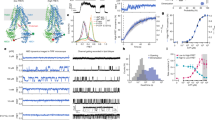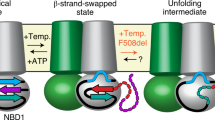Abstract.
Defective function of the cystic fibrosis (CF) transmembrane conductance regulator (CFTR) causes CF, the most frequent lethal inherited disease among the Caucasian population. The structure of this chloride ion channel includes two nucleotide-binding domains (NBDs), whose ATPase activity controls channel gating. Recently, the experimental structures of mouse and human CFTR NBD1 and our model of the human CFTR NBD1/NBD2 heterodimer have provided new insights into specific structural features of the CFTR NBD dimer. In the present work, we provide a structural classification of CF-causing mutations which may complement the existing functional classification. Our analysis also identified amino acid residues which may play a critical role in interdomain interaction and are located at the NBD1-NBD2 interface or on the surface of the dimer. In particular, a cluster of aromatic amino acids, which includes F508 and straddles the two NBDs, might be directly involved in the interaction of the NBD1/NBD2 heterodimer with the channel-forming membrane-spanning domains.
Similar content being viewed by others
Author information
Authors and Affiliations
Corresponding author
Additional information
Received 24 May 2005; received after revision 13 June 2005; accepted 18 June 2005
Rights and permissions
About this article
Cite this article
Eudes, R., Lehn, P., Férec, C. et al. Nucleotide binding domains of human CFTR: a structural classification of critical residues and disease-causing mutations.. Cell. Mol. Life Sci. 62, 2112–2123 (2005). https://doi.org/10.1007/s00018-005-5224-y
Published:
Issue Date:
DOI: https://doi.org/10.1007/s00018-005-5224-y




